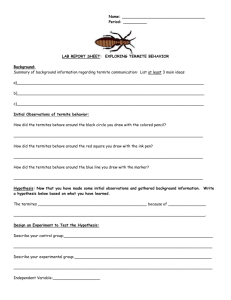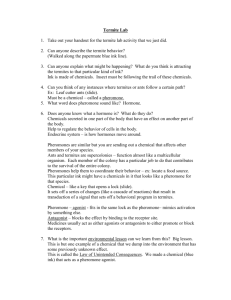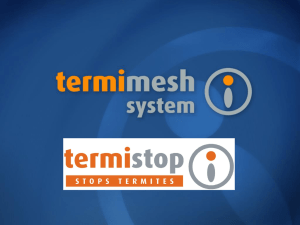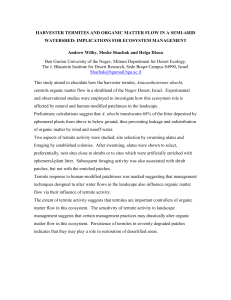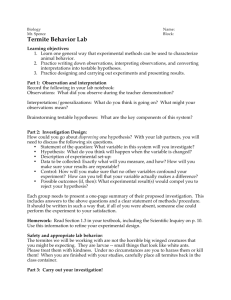Nature_of_Science_5E
advertisement
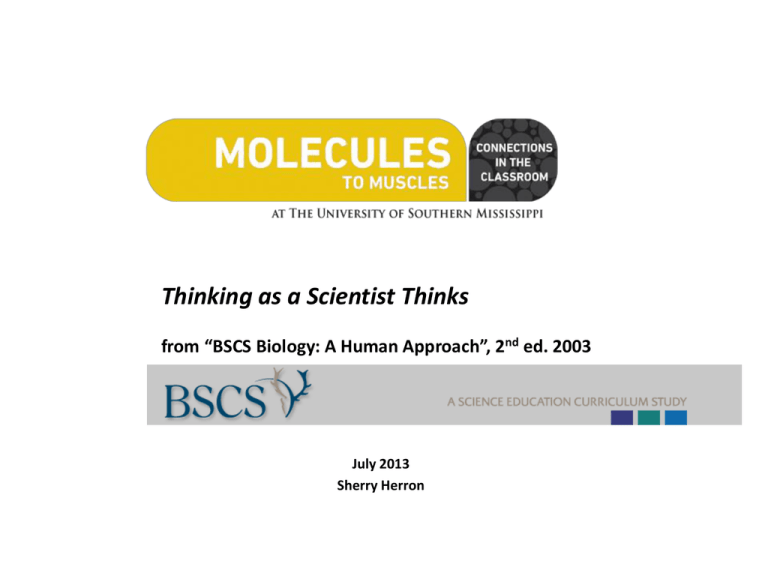
Thinking as a Scientist Thinks from “BSCS Biology: A Human Approach”, 2nd ed. 2003 July 2013 Sherry Herron Worn out................................but data must be recorded You are a scientist, and you were working late last night. While you were writing and drawing a diagram in your journal, you nodded off. You drew the diagram in different colors of ink that looked similar this. BSCS Biology: A Human Approach, 2nd ed. 2003 When you awoke, you found there was a termite (?!) in the middle of the diagram. You watched the termite’s response to the ink on the page, and it made you wonder. Next, you called in your friend, who is also a scientist. Together you made a prediction about what the termite was doing. BSCS Biology: A Human Approach, 2nd ed. 2003 Thinking as a Scientist Thinks • Record at least 3 questions that come to mind as you watch your termite. • Select 1 question you might be able to answer through experimentation. • Record what you predict the termite will do and explain why your prediction is reasonable. • Design an experiment to test your prediction. • Save all test diagrams and record your observations. BSCS Biology: A Human Approach, 2nd ed. 2003 Thinking as a Scientist Thinks • Use the information and observations that you gather to develop a possible explanation for what you observe and a possible answer to your question. Include any additional questions that come up while you are experimenting. • Report out to the class: – The question you tested. – The results you obtained. – The explanation you concluded. BSCS Biology: A Human Approach, 2nd ed. 2003 Thinking as a Scientist Thinks • Participate in a class discussion of the questions, experiments, and ideas about termites. • Read the terms below and identify two additional terms that could be used to describe the way scientists think: Explanation evidence prediction logic • Write a paragraph in your journal to summarize the statement, “Science is a Way of Knowing”. Include the four terms above the two terms that you added. BSCS Biology: A Human Approach, 2nd ed. 2003 Elaborate Options • Nature of Science extension: – Scientists observe without making any judgment. – Scientific observation are objective and value free. – If two scientists run the same experiment and have similar observations, they will develop the same explanation for the results. • Scientific Method: hypothesis, independent variables, dependent variables, controls, constants, etc. • Inductive and Deductive Logic • Constructing Data Tables and Graphs BSCS Biology: A Human Approach, 2nd ed. 2003 Elaborate Options • Biology: Animal Behavior, Adaptations, Insects, Termites, Endocrine Glands, Pheromones • Chemistry: unsaturated aliphatic alcohol (3Z,6Z,8E)-3,6,8-dodecatrien-1-ol and the diterpene (E,E,E)-neocembrene, glycol, phthalates Evaluate Options • • • • Lab report Journal entries, summary, and reflection Oral Poster Presentation Video, Power Point, Prezi, Resources • • • • • • • • • • • http://www.sbs.utexas.edu/jcabbott/courses/bio208web/lectures/scimethod/trail _following_of_termites.htm http://www.nydailynews.com/news/world/termites-eat-chinese-woman-savings65-000-article-1.1372721 HowStuffWorks "How Termites Work" www.howstuffworks.com/termite.htm by Tracy Wilson - in 215 Google+ circles Termites have existed for 50 million years and can be found throughout the world. Learn about termites and find out how termite colonies are structured. Termites - Facts About Termites - Types of Termites ... www.pestworldforkids.org/termites.html Learn all about termites, facts about termites and different types of termites. Termite colonies eat non-stop, 24 hours a day, seven days a week! Termites - BioKIDS - University of Michigan www.biokids.umich.edu/critters/Isoptera/ Termites are found in dark, damp areas whereby they are not exposed to air. They require a source of moisture to survive. In temperate regions, they are found in ... 5E Instructional Model is based on Constructivist Learning Theory 1. Engage: Instruction engages students with questions and creates curiosity. The teacher assesses students’ prior knowledge about the content. 2. Explore: Teacher provides situation and gives directions for exploration (i.e. lab experiment or activity). Teacher provides time for students to complete the work. Students make predictions and gather data. 3. Explain: The teacher encourages the learners’ to explain what they learned. The teacher introduces new terms, ideas and explanations. 4. Elaborate: The teacher encourages learners to apply the new knowledge to investigate further and helps students to practice the new knowledge. 5. Evaluate: The teacher observes students performance to assess their understanding. Students are expected to apply their new knowledge and skills as they perform. (Bybee et al. 2006) Our Fellows do Science! • PLEASE share your knowledge, skills, and enthusiasm for science. BE A MENTOR!!! Intel International Science and Engineering Fair (ISEF) •Administered for over 60 years by Science Service, www.sciserv.org, one of the most respected non-profit organizations advancing the cause of science. •Intel Corp commits more than $3 million annually to promote the competition. •Intel ISEF finalists come from a field of more than 65,000 students who participated in more than 550 Intel ISEF-affiliated science fairs around the world. •More than 1,500 young competitors, grades 9-12, come from 65 countries, regions, and territories. ISEF Stats: •Special awards worth more than $1.5 million (including scholarships, internships, field trips, and lab equipment) are provided by nearly 80 sponsors. •Over 800 prizes and more than $4 million in awards and scholarships given. •Top Prize: Intel Foundation Young Scientist Award, given to three finalists, each receives a $50,000 college scholarship •2008 Winner Natalie Saranga Omattage from the Mississippi School for Mathematics and Science developed a biosensor capable of detecting food contaminants. Natalie Omattage: a 2008 Grand Prize Winner – from Mississippi! ISEF Stats: • 18 Best of Category prizes go to the top-scoring student in each project category. Each student receives a $5,000 scholarship and a computer, with the student’s school and fair director receiving $1,000 for science and math education. •Grand awards are given for 1st ($3,000), 2nd ($1,500), 3rd ($1,000), and 4th ($500) place projects in each category. http://www.societyforscience.org/isef/ Let’s check it out! Mississippi Science and Engineering Fair Each year… • >7000 students in MS participate in regional competitions (7 in MS). • >500 high school students participate at the state level. • >25 winners participate at International SEF • MISSISSIPPI STUDENTS ALWAYS DO WELL Nuts and Bolts • Prepare – Plan your project with a mentor – Get approval. Use ISEF Rules Wizard. – Conduct research – Prepare presentation • School must register. Teacher submits abstract forms. • Students compete. Very Important Websites • http://www.societyforscience.org/isef/ • http://www.usm.edu/science-math-education

